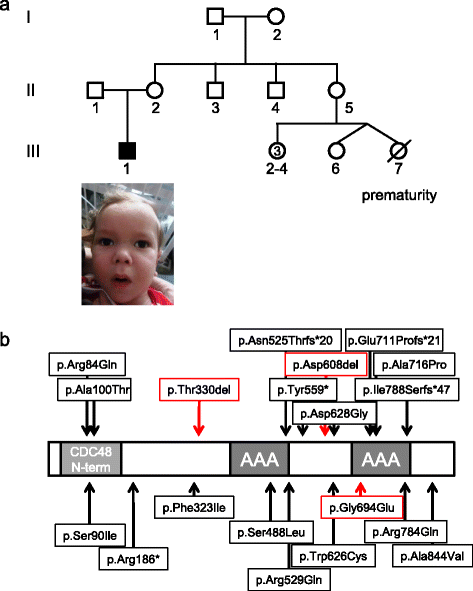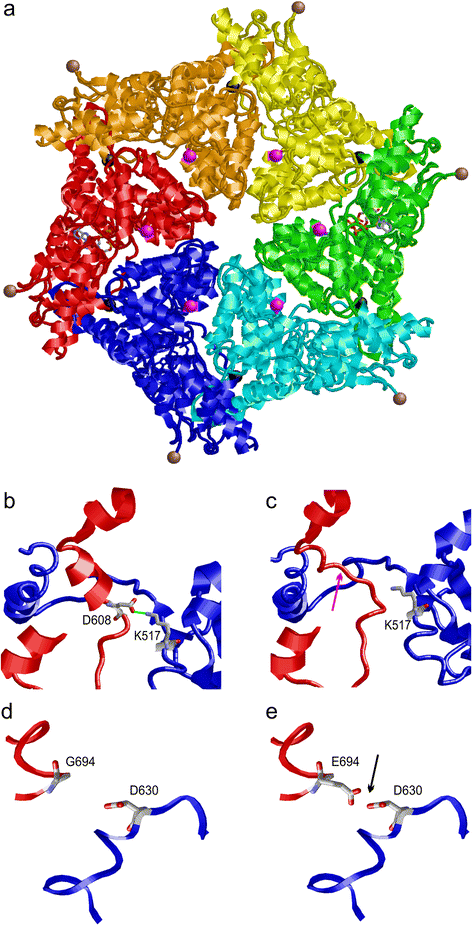SPATA5 mutations cause a distinct autosomal recessive phenotype of intellectual disability, hypotonia and hearing loss
- PMID: 27683084
- PMCID: PMC5041579
- DOI: 10.1186/s13023-016-0509-9
SPATA5 mutations cause a distinct autosomal recessive phenotype of intellectual disability, hypotonia and hearing loss
Abstract
We examined an extended, consanguineous family with seven individuals with severe intellectual disability and microcephaly. Further symptoms were hearing loss, vision impairment, gastrointestinal disturbances, and slow and asymmetric waves in the EEG. Linkage analysis followed by exome sequencing revealed a homozygous variant in SPATA5 (c.1822_1824del; p.Asp608del), which segregates with the phenotype in the family. Molecular modelling suggested a deleterious effect of the identified alterations on the protein function. In an unrelated family, we identified compound heterozygous variants in SPATA5 (c.[2081G > A];[989_991delCAA]; p.[Gly694Glu];[.Thr330del]) in a further individual with global developmental delay, infantile spasms, profound dystonia, and sensorineural hearing loss. Molecular modelling suggested an impairment of protein function in the presence of both variants.SPATA5 is a member of the ATPase associated with diverse activities (AAA) protein family and was very recently reported in one publication to be mutated in individuals with intellectual disability, epilepsy and hearing loss. Our results describe new, probably pathogenic variants in SPATA5 that were identified in individuals with a comparable phenotype. We thus independently confirm that bi-allelic pathogenic variants in SPATA5 cause a syndromic form of intellectual disability, and we delineate its clinical presentation.
Keywords: ARID; Hearing loss; Hypotonia; Microcephaly; NGS.
Figures



References
-
- Rauch A, Wieczorek D, Graf E, Wieland T, Endele S, Schwarzmayr T, Albrecht B, Bartholdi D, Beygo J, Di Donato N, et al. Range of genetic mutations associated with severe non-syndromic sporadic intellectual disability: an exome sequencing study. Lancet. 2012;380:1674–82. doi: 10.1016/S0140-6736(12)61480-9. - DOI - PubMed
-
- Tanaka AJ, Cho MT, Millan F, Juusola J, Retterer K, Joshi C, Niyazov D, Garnica A, Gratz E, Deardorff M, et al. Mutations in SPATA5 Are Associated with Microcephaly, Intellectual Disability, Seizures, and Hearing Loss. Am J Hum Genet. 2015;97:457–64. doi: 10.1016/j.ajhg.2015.07.014. - DOI - PMC - PubMed
-
- Kurata H, Terashima H, Nakashima M, Okazaki T, Matsumura W, Ohno K, Saito Y, Maegaki Y, Kubota M, Nanba E, et al. Characterization of SPATA5-related encephalopathy in early childhood. Clin Genet 2016. doi: 10.1111/cge.12813 - PubMed
Publication types
LinkOut - more resources
Full Text Sources
Other Literature Sources

